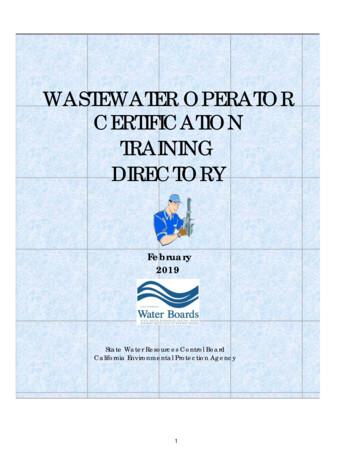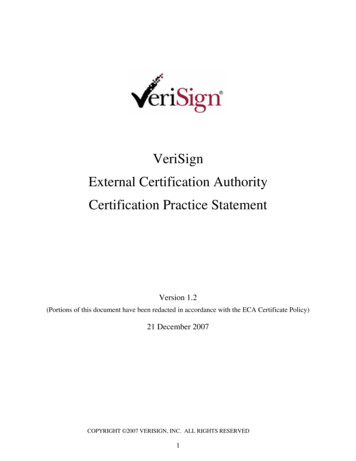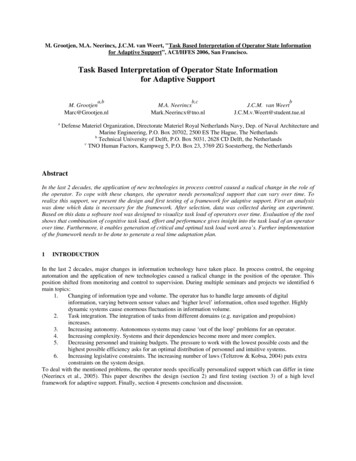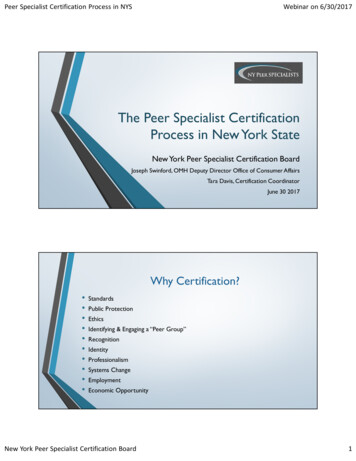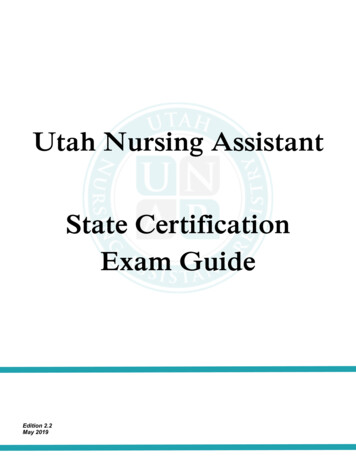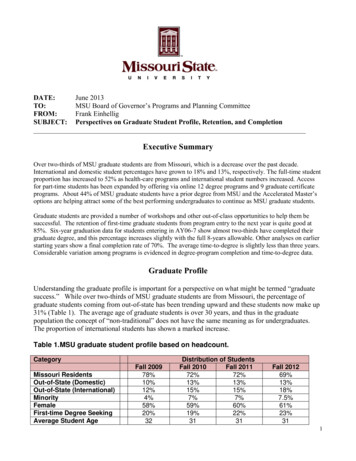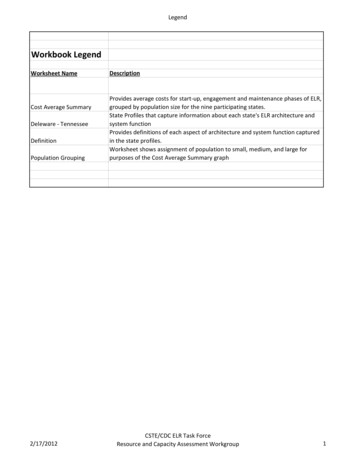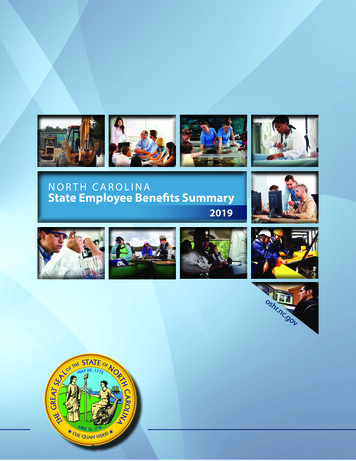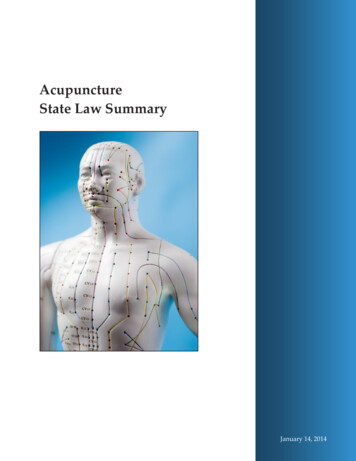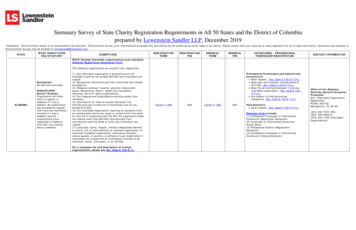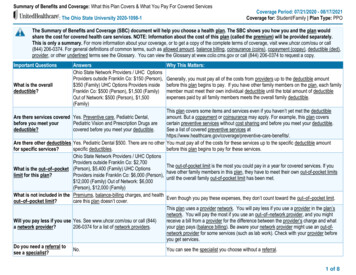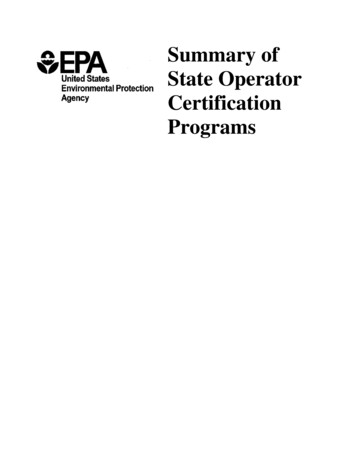
Transcription
Summary ofState OperatorCertificationPrograms
Office of Water (4606M)EPA 816-R-16-002March 2016
Table of ContentsExecutive Summary . 1I: Summary of Existing State Operator Certification Programs . 3Alabama . 4Alaska. 6Arizona . 8Arkansas . 10California. 12Colorado . 14Connecticut . 16Delaware . 18Florida . 20Georgia . 22Hawaii . 24Idaho . 26Illinois . 28Indiana . 30Iowa . 32Kansas . 34Kentucky . 36Louisiana . 38Maine. 40Maryland . 42Massachusetts . 44Michigan . 46Minnesota . 48Mississippi. 50Missouri. 52Montana . 54Nebraska . 56Nevada . 58New Hampshire . 60New Jersey . 62New Mexico . 64New York . 66i
North Carolina . 68North Dakota . 70Ohio . 72Oklahoma . 74Oregon . 76Pennsylvania . 78Puerto Rico . 80Rhode Island. 82South Carolina . 84South Dakota . 86Tennessee . 88Texas . 90Utah . 92Vermont . 94Virginia . 96Washington . 98West Virginia . 100Wisconsin . 102Wyoming . 104II: Summary Tables of Existing Operator Certification Programs . 106Implementing Authority . 107Coverage . 110Reciprocity . 113Certification Board or Equivalent Agency . 116Classification of Systems/Facilities. 118Renewal . 122Recertification . 124Enforcement . 126ii
Executive SummaryUnder section 1419(b) of the Safe Drinking Water Act (SDWA), EPA is directed to withhold 20percent of the funds a state was otherwise entitled to receive under SDWA section 1452 (theDrinking Water State Revolving Fund (DWSRF) Program) unless the state adopted and beganimplementing a program that meets the requirements of EPA’s Guidelines for the Certification(and Recertification) of Operators of Community and Nontransient Noncommunity Public WaterSystems (64 Fed. Reg. 5915). In order to continue to receive funding, state operator certificationprogram adoption was required by February 5, 2001, (That is, 2 years after final publication ofEPA’s Guidelines). Each state met this deadline and EPA approved all of the state programs,allowing full funding of allocations under the DWSRF.This document summarizes each state’s response to Section 1419(b) of the SDWA. It is areference tool for making comparisons among state programs for certifying operators ofcommunity water systems (CWSs) and nontransient noncommunity water systems (NTNCWSs).The document is organized as follows:I.State Summaries of Existing Operator Certification Programs, which provides adetailed look at each state’s program, including information on:A. Authorization - Statutory and regulatory citations that authorize the OperatorCertification Program and the implementing agency or agencies.B. Classification of Systems, Facilities, and Operators - Description of the method by whichthe state classifies its water supply systems, such as by system type, complexity of systemcomponents (for example, production, treatment, distribution), or size (for example,population served or volume in either gallons per day (GPD) or million gallons per day(MGD)).C. Operator Qualifications - Qualifications required for certification. For example, moststates require a high school diploma (HSD) or equivalent, such as the GeneralEducational Development (GED) test. Some states offer an Operator-in-Training (OIT)program for operators who receive temporary certification while working at a PWS asthey seek full certification. Also describes any applicable grandparenting requirements.(Grandparenting, can provide an exception for operators to be certified even if they didnot meet the new or modified program requirements established by February 2001).D. Enforcement - Description of the methods used by the state to enforce operatorcertification requirements (including actions against systems, operators, or both), and theagency or agencies that carry out enforcement actions.E. Certification Renewal - Ongoing requirements that an operator must meet to maintain acertification (for example, continuing education, contact hours, renewal period, andexperience).F. Resources Needed to Implement the Program – List of funding sources, including feebased programs, staffing resources, budget, and data management activities. Mostprograms draw on a variety of state resources and staff that may not be clearly identified1
on program Web sites, such as data management or field inspection staff. These staff maybe funded through federal funds (such as set-aside funds from the DWSRF, the PublicWater Supply Supervision (PWSS) grant, or the Expense Reimbursement Grant (ERG))or other state funding such as state general funds.G. Recertification - Identification of recertification requirements to renew a certificate, orloss of a certificate due to revocation or suspension.H. Stakeholder Involvement - Description of stakeholder involvement in OperatorCertification Program implementation and review, including identification of anyadvisory boards, committees, etc.I. Program Review - Information on whether there is a regular formal review (internal orexternal) process for the state’s program.II.Summary Tables of Existing Operator Certification Programs, which serve as quickreferences and allow for easy comparison among the programs.2
I: State Summary of Existing Operator Certification Programs3
StateAlabamaAuthorizationCode of Alabama1975: § 22-22A, §22-25-1 through22-25-15, and TheAlabamaDepartment ofEnvironmentalManagement(ADEM) Admin.Code R. 335-10-1.Last amended in2007.ADEM’s Permitsand ServicesDivision isauthorized toimplement theOperatorCertificationProgram.Classification of Systems,Operator QualificationsFacilities, and OperatorsWater distribution systems: Applicants must score 70 percenton written exam. MinimumGrade IC: Waterexperience required within 5 yearsDistribution Systems.of passing exam:Water treatment plants:Grade I: 12 monthsGrade II: Basic groundGrade II: 18 months in a Grade IIwater source (treatmentfacility or 24 months combinedGrade I, and II, III, or IV experienceincluding aeration andpressure filtration).Grade III: 24 months in a Grade IIIfacility or 36 months combinedGrade III: Advanced groundGrade II, III, or IV experiencewater (treatment usingGrade IV: 24 months in a Grade IVflocculation & clarifier).facilityGrade IV: Surface waterExperience may be acquired insource or groundwaterapplicable grade level or one gradesource under the influencebelow, except Grade IV Waterof surface water.which requires surface watertreatment experience. Approvedtraining programs, classes, orseminars may substitute for up to 12months of experience.Operator Intern title applies topeople that have successfully passedexaminations but have not achievedthe required experience.Grandparenting: Not allowed.4EnforcementThe Director of theDepartment mayrevoke or suspendcertificates, andinitiate proceedings toenforce therequirements of Codeof Alabama 1975 2225-1 to 22-25-15.Proceedings mayinclude: a notice ofviolation; anadministrative orderdirecting compliance;an administrative orderassessing a civilpenalty of between 100 and 25,000; anda civil or criminalaction.Certification RenewalCertificates must berenewed every 3 years.Operators must complete24 continuing educationhours (CEH), percertificate over the 3-yearperiod. For a list ofapproved CEH sources, seepage 15 es/Div10Eff4-3-07.pdf.
StateAlabamaResources Needed ToImplement the ProgramExam: 270Certification: 105Paper renewal: 80Online renewal: 60Late renewal: 180Reciprocity: 150Funding: Funded through fees.Exam is administered by AppliedMeasurement Professionals(AMP).RecertificationStakeholder InvolvementProgram ReviewA complete application forrenewal must be received atleast 30 days prior to theexpiration date of thecertificate. Operators whofail to achieve CEHrequirements within the 3year renewal period may,upon approval, be grantedan additional 180 days toacquire their CEHs.The Alabama Water PollutionControl Association (AWPCA)and the Alabama Rural WaterAssociation (ARWA) providepreparatory certification trainingcourses and also CEH training forcertification renewal.Exams are reviewed by a MultiBranch ADEM Operator CertificationCommittee every 5 years or morefrequently, based on examineefeedback.ADEM also holds an annualtraining conference for operators.For a late applicationsubmittal, an operator mayapply within 180 days of thecertificate’s expiration dateand pay a late fee inaddition to the certificationfee. The operator may notpractice as a certifiedoperator until the effectivedate of the new certificate.An operator who fails tosubmit an application forrenewal within 180 daysafter the certificate’sexpiration must reapply andtake a new exam.Program Web site: fication.cnt5Internal Program Reviews areconducted annually and ExternalProgram Reviews are conducted on anon-going basis through quarterlymeetings with Alabama certifiedoperator committees (AWPCA andARWA).
StateAlaskaAuthorization Classification of Systems, Facilities,and OperatorsTitle 46,Distribution systems are classified asChapter 30 of Class I-IV based on number of servicethe Alaskaconnections.Statutes, andDistribution systems may be classifiedChapter 74,one class higher than the classificationArticles 1-3 ofdescribed above based on five or morethe Alaskapressure zones and whether water isAdministrativecirculated to prevent freezing.Code (AAC).Last amended Treatment system points are assignedaccording to design capacity, sourcein 2010.water, and complexity of treatment, asThefollows:Department ofEnvironmental Class I: 1 - 30 pointsConservationClass II: 31 - 55 pointsClass III: 56 - 75 points(DEC)implements the Class IV: 76 pointsOperatorSystems that serve fewer than 100Certificationconnections or fewer than 500 people,Program.or small treated or untreated watersystems using surface water orGWUDI, are classified and treatedseparately. More information onsystem classification is available 18%20AAC%2074.pdf.Operator QualificationsCertificationRenewalAll operators must have an HSD or GED, pass The DEC mayCertification is validan Association of Boards of Certificationrevoke afor 3 years(ABC) exam for the class of system for which certificate if thebeginning onthey will be certified, and have at least thefollowing acts of January 1 of the yearof issue. Ten hoursfollowing experience:misconductoccurred: fraud or of approved trainingWater Distributionequals onedeceit inProvisional: 3 months or completion of course obtaining theContinuingcertificate or plant Education UnitLevel I: 1 yearrecord keeping,(CEU). The numberLevel II: 3 yearsgross negligence of CEU’s that eachLevel III: 4 years, 1 additional year ofor a substantiallevel of operatoreducationviolation ofmust completeLevel IV: 6 years, 1 additional year ofrequirements.during the 3-yeareducationperiod are asWater Treatmentfollows:Provisional: 3 months or completion of courseLevel I: 1 yearLevel II: 3 yearsLevel III: 4 years, 2 additional years ofeducationL
I. State Summaries of Existing Operator Certification Programs, which provides a detailed look at each state’s program, including information on: A. Authorization - Statu
